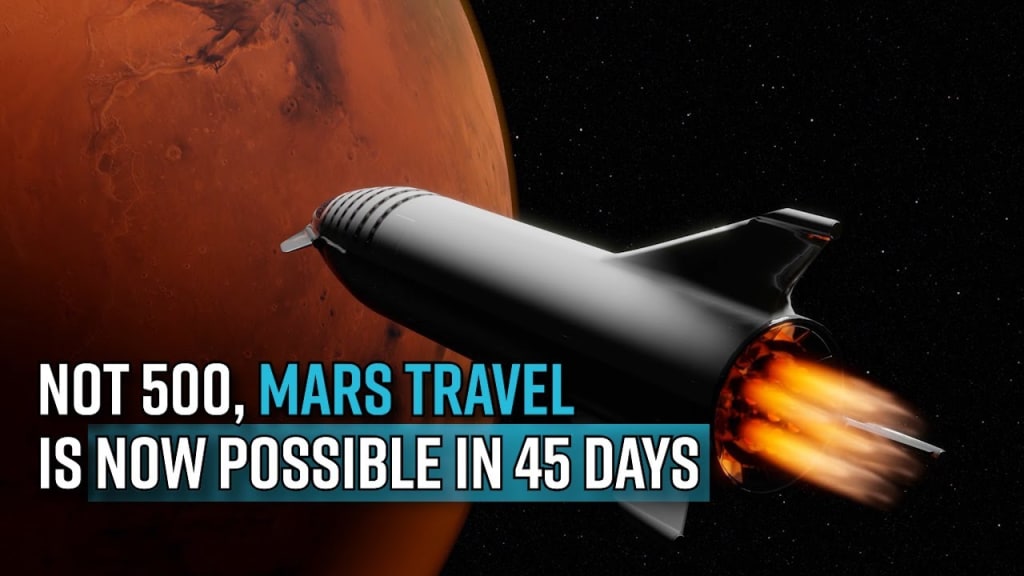Now Possiable 45 days to mars
Nuclear Thermal and Nuclear Electric Propulsion

Nuclear thermal propulsion (NTP) and nuclear electric propulsion (NEP) are two advanced propulsion technologies that use nuclear energy to power spacecraft. Both NTP and NEP have the potential to greatly improve the performance of spacecraft and enable new missions that are currently impossible with traditional chemical propulsion systems.
NTP uses a nuclear reactor to heat a working fluid, such as hydrogen, which is then expelled through a nozzle to generate thrust. The high temperature of the working fluid, which can reach up to several thousand degrees, enables NTP systems to achieve much higher specific impulses (a measure of the efficiency of a propulsion system) than chemical propulsion systems. This means that NTP systems can provide much more thrust per unit of propellant, allowing spacecraft to accelerate faster and travel further on a given amount of fuel.
One of the key advantages of NTP is its high thrust-to-weight ratio, which means that it is capable of providing a lot of thrust for a relatively small and lightweight propulsion system. This makes NTP well-suited for use in heavy-lift launch vehicles and spacecraft designed for high-speed interplanetary travel.
NEP, on the other hand, uses a nuclear reactor to generate electricity, which is then used to power an electric propulsion system. Electric propulsion systems generate thrust by accelerating ions (charged atoms or molecules) to extremely high velocities and expelling them through a nozzle. Because electric propulsion systems do not rely on the combustion of chemical propellants, they can achieve much higher specific impulses than chemical propulsion systems.
One of the main advantages of NEP is its high efficiency, which enables spacecraft to travel much further on a given amount of fuel than they would be able to with traditional chemical propulsion systems. This makes NEP well-suited for use in long-duration missions, such as deep-space exploration and interstellar travel.
Both NTP and NEP have been studied extensively by NASA and other space agencies around the world, and both technologies have been demonstrated in various forms of ground testing. However, there are still many technical challenges that need to be overcome before either NTP or NEP can be used in operational spacecraft.
One of the main challenges with NTP is the development of a nuclear reactor that is small, lightweight, and safe enough for use in a spacecraft. Additionally, NTP systems also need to be able to withstand the extreme temperatures and pressures associated with the high-speed propulsion of a working fluid.
NEP also faces many challenges, including the development of efficient and reliable ion thrusters, as well as the ability to handle the high power levels required for electric propulsion.
Despite these challenges, both NTP and NEP have the potential to revolutionize space travel and open up new possibilities for exploring the solar system and beyond. However, it will take a significant amount of research and development to overcome the technical challenges and to make these technologies practical and cost-effective for use in operational spacecraft.
In summary, Nuclear Thermal Propulsion and Nuclear Electric Propulsion are advanced propulsion technologies that use nuclear energy to power spacecraft. NTP uses nuclear reactor to heat a working fluid, such as hydrogen, which is then expelled through a nozzle to generate thrust. NEP uses a nuclear reactor to generate electricity, which is then used to power an electric propulsion system. NTP has high thrust-to-weight ratio, which makes it well-suited for heavy-lift launch vehicles and spacecraft designed for high-speed interplanetary travel. NEP has high efficiency and well-suited for long-duration missions. Both technologies have been studied extensively, but there are still many technical challenges that need to be overcome before either NTP or NEP can be used in operational spacecraft.
A trip to Mars typically takes around 6 to 8 months using current propulsion technology, however, NASA and other space agencies are currently developing new technologies that could potentially reduce the travel time to as little as 45 days.
One of the main ways to shorten the travel time to Mars is to use more advanced propulsion systems. Nuclear thermal propulsion (NTP) and nuclear electric propulsion (NEP) are two advanced propulsion technologies that are being researched as potential solutions for faster Mars travel. NTP uses a nuclear reactor to heat a working fluid, such as hydrogen, which is then expelled through a nozzle to generate thrust. NEP uses a nuclear reactor to generate electricity, which is then used to power an electric propulsion system. Both NTP and NEP have the potential to greatly improve the performance of spacecraft and enable new missions that are currently impossible with traditional chemical propulsion systems.
Another way to reduce travel time to Mars is to take advantage of the planets' positions in their orbits, known as a "transfer window". These transfer windows open every 26 months and last for a few weeks. During this time, the distance between Earth and Mars is at its closest, allowing for the shortest possible travel time.
Finally, NASA is also researching the use of a "gravity assist" maneuver, where a spacecraft would use the gravity of another planet to increase its velocity and shorten the travel time.
In summary, a trip to Mars currently takes around 6 to 8 months using traditional propulsion technology, however, NASA and other space agencies are researching new technologies that could potentially reduce the travel time to as little as 45 days. These include the use of more advanced propulsion systems, such as NTP and NEP and taking advantage of transfer windows and gravity assist maneuvers. These technologies are still in the research and development phase, and it will take a significant amount of work to make them practical and cost-effective for use in operational missions.
About the Creator
Gajendira Kumar
I am Not a Legend I am the Lengends Maker by GAJAJI
Content Creator
Future Technology






Comments
There are no comments for this story
Be the first to respond and start the conversation.